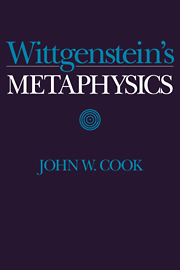Book contents
- Frontmatter
- Contents
- Preface
- List of Abbreviations
- Introduction
- Part I From Idealism to Pure Realism
- Part II The Metaphysics of Wittgenstein's Later Philosophy
- Part III Causation and Science in a Phenomenal World
- 11 Hume on Causation
- 12 Wittgenstein's Humean View of Causation
- 13 The Problem of Induction
- Part IV Logical Possibilities and the Possibility of Knowledge
- Part V The Past, Memory, and The Private Language Argument
- Name Index
- Subject Index
13 - The Problem of Induction
Published online by Cambridge University Press: 05 November 2011
- Frontmatter
- Contents
- Preface
- List of Abbreviations
- Introduction
- Part I From Idealism to Pure Realism
- Part II The Metaphysics of Wittgenstein's Later Philosophy
- Part III Causation and Science in a Phenomenal World
- 11 Hume on Causation
- 12 Wittgenstein's Humean View of Causation
- 13 The Problem of Induction
- Part IV Logical Possibilities and the Possibility of Knowledge
- Part V The Past, Memory, and The Private Language Argument
- Name Index
- Subject Index
Summary
In his post-Tractatus years Wittgenstein represented himself as solving – or dispelling – philosophical problems by paying close attention to the use of those words that lead to philosophical puzzlement. We have seen that very often, at least, he did not do what he claimed to be doing. In this chapter I want to call attention to another instance in which, rather than paying attention to what we actually say, he simply invented something in order to reach conclusions that suited him, namely, his way of dealing with philosophical skepticism regarding ‘induction.’
Induction and Skepticism
Induction is itself one of the myths invented by empiricists. There could never be any such thing. A philosopher could think that scientists (and others) employ ‘the inductive method’ only if he also thinks that nothing causes anything (except in Hume's ersatz sense). The idea behind speaking of ‘the inductive method’ is this: we experiment in order to discover regularities in nature, and the point of seeking out regularities is that we have to deal with the future in various ways. The more instances we have found of a given regularity, the better equipped we are to predict and to act. But what does “better equipped” mean here? Empiricists (Humeans) have differed widely on this matter. Some have said that the more instances we have found of a regularity the more probable it is that the regularity will persist in the future.
- Type
- Chapter
- Information
- Wittgenstein's Metaphysics , pp. 195 - 204Publisher: Cambridge University PressPrint publication year: 1994



